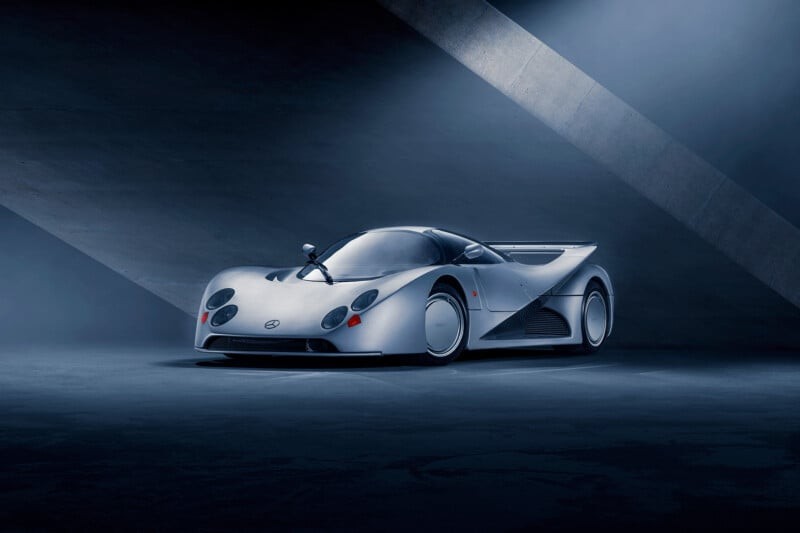In the realm of automotive legends, certain cars transcend mere metal and mechanics, becoming whispered myths among enthusiasts. The Mercedes-Benz C1000 is one such vehicle. So rare it’s practically automotive folklore, even seasoned car aficionados might only dream of glimpsing this machine. Born in 1994, this near-270-mile-per-hour marvel, commissioned for an oil magnate, is as much a testament to engineering prowess as it is an enigma. It’s a unicorn, even amongst unicorns. Imagine the surprise then, for automotive photographer Blair Bunting, to find himself face-to-face with this very legend in an empty studio. What began as a childhood dream, however, quickly morphed into a unique professional challenge.
The design language of the Mercedes-Benz C1000 owes more to an aerodynamic wedge than conventional car aesthetics. While mainstream automotive design evolves incrementally, the world of bespoke, one-off creations like the C1000 operates without such constraints. It’s immediately apparent that the C1000 was sculpted purely for velocity, sacrificing traditional notions of car design at the altar of speed. This singular focus presented a formidable challenge when it came to capturing its essence through photography. Standard lighting approaches simply wouldn’t suffice for a vehicle this unconventional. Even for a seasoned commercial photographer accustomed to complex setups, illuminating the C1000 proved to be a uniquely demanding task.
Prior research offered limited practical guidance for lighting the Mercedes-Benz C1000. To prepare, Bunting even experimented with wedge-shaped objects, anticipating the car’s extreme angles. The core difficulty lies in the juxtaposition of the sharp, angular body with the inherently rounded driver compartment. This break in the car’s shoulder line necessitates a blend of lighting techniques. The solution involved combining background light to create visually appealing intersecting lines, while simultaneously employing soft lighting to avoid harsh reflections on the car’s assertive body lines. This delicate balance was crucial to accurately represent the car’s form.
To execute this vision, Profoto strobes were utilized in conjunction with continuous hot lights. The strobes established the overall scene, while the hot lights were employed to subtly paint in gradients, adding depth and nuance to the car’s surfaces. This technique, reminiscent of methods Bunting previously used photographing athletes with mixed lighting, proved essential to capturing the Mercedes-Benz C1000 with lifelike fidelity. Fortuitously, the C1000’s monochromatic palette – a flat grey with black accents and neutral-toned rims – simplified the lighting process. The absence of vibrant colors meant no need for color gels, allowing for a laser focus on light modifiers and precise light shaping to match the studio setting and the car’s unique form.
Despite prior images, the Mercedes-Benz C1000 revealed itself to be even more angular in person than anticipated. For car enthusiasts, its sharp lines bear a resemblance to the iconic Porsche 962 race car. Featuring upward-swinging doors and near-vertical sides, the design hints at performance-oriented engineering. Intriguingly, unlike the Porsche’s central driver seat, the Mercedes offers a bench seat for two. A passenger ride revealed an unconventional seating position, angled noticeably towards the driver, underscoring the driver-centric nature of this machine. And let’s not forget the bold, bright red leather interior, a surprising contrast to the car’s stealthy exterior.
Photographing the Mercedes-Benz C1000 became a meticulously choreographed dance of light and shadow. Assistants became mobile light stands, carefully moving lights along the car’s flanks as Bunting timed the exposures. Precise light painting instructions, like “3 seconds on rear bumper, 7 seconds on the side, and 1 second on the front,” ensured controlled illumination. This method preserved the texture of the car’s metal skin, something a large softbox would have obscured. Fine-tuning the light angles also injected a sense of curve and dimension into the car’s inherently flat sides in the resulting images. Often, strobe flashes initiated the exposure, transitioning into continuous light painting. However, capturing separate frames for strobes proved more effective. Another crucial lesson learned: dark clothing was paramount. Even minor reflections from white clothing or jewelry could create unwanted specular highlights, requiring extensive retouching.
Once the optimal approach to lighting and angles was deciphered, a streamlined workflow emerged, allowing for the efficient creation of a compelling image set. The successful shoot culminated in a celebratory round of beers for the hardworking crew. For Bunting, photographing the Mercedes-Benz C1000 was a complex journey, a blend of childhood fascination and professional rigor. While grateful for the experience of encountering this automotive legend, the sheer intensity of the shoot left him relieved at the prospect of it being a singular event.
Based on the photographic work and experiences of Blair Bunting, a Phoenix-based commercial photographer. For more of his automotive photography and insights, visit Blair Bunting’s Website.
